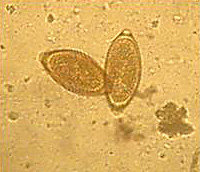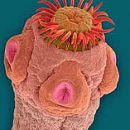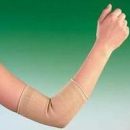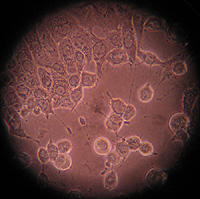What is trichocephalosis? As the disease flows? How to treat tricocephalosis? Answers to the questions you will find in the article.
Content
Trichocephalosis
Trichocephalosis - Helmintosis (nematodosis), a glitstic disease that flows with the lesion of the gastrointestinal tract.
The pathogen is a round worm (nematode) Trichuris Trichiura (Trichocephalus Trichiurus)
Front
Part of the Helmint Hair-shaped (hence the name of Helmint -
Vlasman), rear end thickened. Male long 30-45 mm, tail
part of the spiraloid is bent, it is an intestine. Female length
35-55 mm, the tail end is slightly bent, there are intestines and
uterus. Life expectancy - 5 years. Eggs of yellowish-brown,
remind lemon with transparent and colorless plugs on the poles;
dimensions 47-52x22-23 μm; The content is fine-grained, covered
Multilayer smooth shell.
 Final
Final
Host and source of infection - man. Path of infection -
fecal-oral (The mechanism of penetration of the causative agent from the intestine of the patient in the mouth of the organism of another person). The disease is common everywhere in countries with
Warm and wet climate, especially in the tropics (up to 80% of all cases).
The incidence in the world - 1 billion. Cases per year. Most often
Trichocephalons are observed with the use of agricultural products,
Grown on the fields with a violation of the soil disinfection regime.
The powerman parasitates in a blind intestine and a worm-shaped process,
massive contiguities (the number of individuals reaches 3,000 or more) - throughout
Tolstone to the rear pass. Adults are fixed on the wall
guts, permeating her thin front end, the thick end of the body hangs
In the intestinal lumen.
Daily female allocates 3000-10000 eggs. WITH
Fekes immature eggs fall into the soil, where with a humidity of 70-90% and
The temperature of 15-35s occurs their ripening, and larvae are formed having a stallow-like
Education at the front end. Depending on temperature time
Ripening takes from 2 weeks to 3-4 months, eggs can be saved in the soil
1-2 years. From eggs that penetrate the intestine of a person, there are infected larvae, which are embedded in the mucous membranes of the small intestine,
where are within 3-10 days. Then the larvae will slowly migrate
intestinal lumen in the blind and rising hatch. Here,
Introduced into the mucous membrane, they are transformed into 1-3 months
hawk worms and begin to lay eggs. Latest with feces
fall into the soil, where under favorable conditions after 2-4 weeks
develop to invasive stages.
As the disease flows
In most cases (with insignificant infection), the disease proceeds asymptomatic. Symptoms
(with a large number of parasites): abdominal pain, increased
fatigue, loss of appetite, elevated salivation, constipation
(Sometimes alternated with diarrhea), hypo- or normal anemia. In places of clusters of parasites, infiltrates and erosion are formed. In tropical regions, with intensive invasions, there are cases of hemocolithic (acute colitis with blood intake in feces) in children and women in the direction of the rectum.
Research Method - Detection of Parasite Eggs in Feling.
How to treat tricocephalosis
- Furniture of 100 mg 2 p / day for 3 days. If necessary, the course is repeated with an interval of 1-1.5 months.
- In contraindications to furnishings - oxygen therapy (the introduction of oxygen through the intestine probe).









